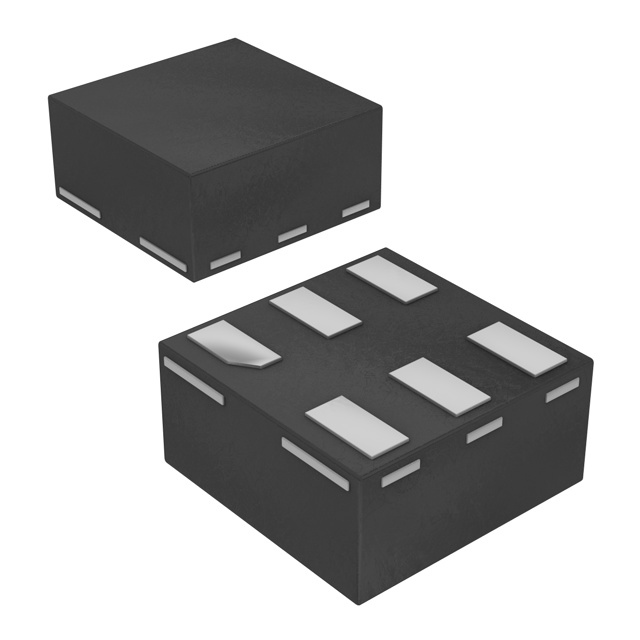Consulte las especificaciones para obtener detalles del producto.

SN74AXC1T45DEAR
Product Overview
- Category: Integrated Circuit (IC)
- Use: Signal Level Shifter
- Characteristics: Bi-directional voltage level translator with automatic direction sensing
- Package: 6-pin SOT-23 package
- Essence: Translates signals between different voltage levels in electronic circuits
- Packaging/Quantity: Available in tape and reel packaging, quantity varies based on customer requirements
Specifications
- Supply Voltage Range: 1.65V to 3.6V
- High-Level Input Voltage: 0.7 x VCC to VCC + 0.3V
- Low-Level Input Voltage: -0.3V to 0.3V
- High-Level Output Voltage: 0.7 x VCC to VCC + 0.3V
- Low-Level Output Voltage: -0.3V to 0.3V
- Maximum Operating Frequency: 100 MHz
- Operating Temperature Range: -40°C to 85°C
Detailed Pin Configuration
The SN74AXC1T45DEAR has a total of 6 pins:
- VCCA: Power supply input for A-side logic
- A1: Input/output pin for A-side logic
- GND: Ground reference
- B1: Input/output pin for B-side logic
- OE: Output enable control pin
- VCCB: Power supply input for B-side logic
Functional Features
- Bi-directional voltage level translation: Allows seamless translation of signals between different voltage domains.
- Automatic direction sensing: The device automatically detects the direction of data flow and adjusts the translation accordingly.
- Wide supply voltage range: Supports operation from 1.65V to 3.6V, making it compatible with various systems.
- High-speed operation: Capable of translating signals at frequencies up to 100 MHz.
- Low power consumption: Designed to minimize power consumption, making it suitable for battery-powered applications.
Advantages and Disadvantages
Advantages: - Easy integration: Compact package and simple pin configuration facilitate easy integration into existing circuit designs. - Automatic direction sensing: Eliminates the need for additional control signals, simplifying system design. - Wide supply voltage range: Provides flexibility in interfacing with different voltage domains. - High-speed operation: Enables efficient signal translation in time-critical applications.
Disadvantages: - Limited number of translation channels: The device supports only one bidirectional channel, which may be insufficient for complex systems requiring multiple translations. - Temperature limitations: The operating temperature range of -40°C to 85°C may restrict its use in extreme environments.
Working Principles
The SN74AXC1T45DEAR utilizes a combination of MOSFETs and level-shifting circuitry to achieve bi-directional voltage level translation. The automatic direction sensing feature detects the logic levels on both sides of the translator and adjusts the translation accordingly. When the OE pin is low, the device is enabled, allowing bidirectional data flow. Conversely, when the OE pin is high, the device is disabled, effectively isolating the A-side and B-side logic.
Detailed Application Field Plans
The SN74AXC1T45DEAR finds applications in various electronic systems that require voltage level translation between different domains. Some common application areas include:
- Microcontrollers: Facilitates communication between microcontrollers operating at different voltage levels.
- Communication interfaces: Enables seamless interfacing between devices with different logic voltage requirements, such as UART, I2C, SPI, etc.
- Battery-powered devices: Allows efficient translation of signals in portable electronics, extending battery life.
- Sensor networks: Supports voltage level translation in sensor networks, enabling interoperability between different sensor modules.
Detailed and Complete Alternative Models
- SN74LVC1T45: Similar voltage level translator with a wider supply voltage range (1.65V to 5.5V).
- TXB0104: Four-channel bidirectional voltage level translator with automatic direction sensing.
- PCA9306: Dual bidirectional I2C-bus and SMBus voltage level translator.
These alternative models offer similar functionality and can be considered based on specific application requirements.
Word count: 536 words
Enumere 10 preguntas y respuestas comunes relacionadas con la aplicación de SN74AXC1T45DEAR en soluciones técnicas
Sure! Here are 10 common questions and answers related to the application of SN74AXC1T45DEAR in technical solutions:
Q1: What is SN74AXC1T45DEAR? A1: SN74AXC1T45DEAR is a single-bit dual-supply bus transceiver with configurable voltage translation and integrated pull-up resistors.
Q2: What is the voltage range supported by SN74AXC1T45DEAR? A2: SN74AXC1T45DEAR supports voltage translation between 1.2V and 3.6V.
Q3: Can SN74AXC1T45DEAR be used for bidirectional level shifting? A3: Yes, SN74AXC1T45DEAR can perform bidirectional level shifting between two different voltage domains.
Q4: How many data lines can SN74AXC1T45DEAR handle? A4: SN74AXC1T45DEAR can handle a single data line (1-bit).
Q5: Does SN74AXC1T45DEAR have built-in pull-up resistors? A5: Yes, SN74AXC1T45DEAR has integrated pull-up resistors that can be enabled or disabled as per the application requirements.
Q6: What is the maximum data rate supported by SN74AXC1T45DEAR? A6: SN74AXC1T45DEAR can support data rates up to 100 Mbps.
Q7: Can SN74AXC1T45DEAR be used in I2C applications? A7: Yes, SN74AXC1T45DEAR can be used in I2C applications for voltage level translation between SDA and SCL lines.
Q8: Is SN74AXC1T45DEAR compatible with 5V systems? A8: No, SN74AXC1T45DEAR is not compatible with 5V systems. It is designed for lower voltage domains.
Q9: Can SN74AXC1T45DEAR be used in battery-powered applications? A9: Yes, SN74AXC1T45DEAR can be used in battery-powered applications as it supports low-power operation.
Q10: Does SN74AXC1T45DEAR have any special power-up sequencing requirements? A10: No, SN74AXC1T45DEAR does not have any special power-up sequencing requirements. It can be powered up in any order.
Please note that these answers are general and may vary depending on the specific application and requirements. It is always recommended to refer to the datasheet and consult the manufacturer for detailed information.

